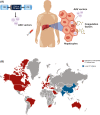Impact of novel hemophilia therapies around the world
- PMID: 35434467
- PMCID: PMC9004233
- DOI: 10.1002/rth2.12695
Impact of novel hemophilia therapies around the world
Abstract
Hemophilia A and B are hereditary bleeding disorders, characterized by factor VIII or IX deficiencies, respectively. For many decades, prophylaxis with coagulation factor concentrates (replacement therapy) was the standard-of-care approach in hemophilia. Since the 1950s, when prophylaxis started, factor concentrates have been improved with virus inactivation and molecule modification to extend its half-life. The past years have brought an intense revolution in hemophilia care, with the development of nonfactor therapy and gene therapy. Emicizumab is the first and only nonreplacement agent to be licensed for prophylaxis in people with hemophilia A, and real-world data show similar efficacy and safety from the pivotal studies. Other nonreplacement agents and gene therapy have ongoing studies with promising results. Innovative approaches, like subcutaneous factor VIII and lipid nanoparticles, are in the preclinical phase. These novel agents, such as extended half-life concentrates and emicizumab, have been available in resource-constrained countries through the constant efforts of the World Federation of Haemophilia Humanitarian Aid Program. Despite the wide range of new approaches and therapies, the main challenge remains the same: to guarantee treatment for all. In this article, we discuss the evolution of hemophilia care, global access to hemophilia treatment, and the current and future strategies that are now under development. Finally, we summarize relevant new data on this topic presented at the ISTH 2021 virtual congress.
Keywords: blood coagulation factors; emicizumab; factor IX; factor VIII; genetic therapy; hemophilia.
© 2022 The Authors. Research and Practice in Thrombosis and Haemostasis published by Wiley Periodicals LLC on behalf of International Society on Thrombosis and Haemostasis (ISTH).
Figures


References
-
- Blanchette VS, Key NS, Ljung LR, et al. Definitions in hemophilia: communication from the SSC of the ISTH. J Thromb Haemost. 2014;12(11):1935‐1939. - PubMed
-
- Mancuso ME, Mahlangu JN, Pipe SW. The changing treatment landscape in haemophilia: from standard half‐life clotting factor concentrates to gene editing. Lancet. 2021;397(10274):630‐640. - PubMed
-
- Pierce GF, Haffar A, Ampartzidis G, et al. First‐year results of an expanded humanitarian aid programme for haemophilia in resource‐constrained countries. Haemophilia. 2018;24(2):229‐235. - PubMed
-
- Nilsson IM, Berntorp E, Lofqvist T, Pettersson H. Twenty‐five years’ experience of prophylactic treatment in severe haemophilia A and B. J Intern Med. 1992;232(1):25‐32. - PubMed
LinkOut - more resources
Full Text Sources
Miscellaneous

